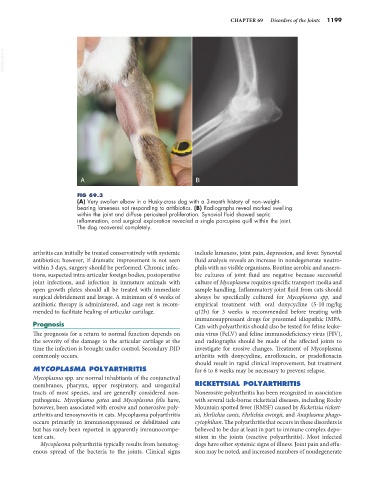Page 1227 - Small Animal Internal Medicine, 6th Edition
P. 1227
CHAPTER 69 Disorders of the Joints 1199
VetBooks.ir
A B
FIG 69.3
(A) Very swollen elbow in a Husky-cross dog with a 3-month history of non–weight-
bearing lameness not responding to antibiotics. (B) Radiographs reveal marked swelling
within the joint and diffuse periosteal proliferation. Synovial fluid showed septic
inflammation, and surgical exploration revealed a single porcupine quill within the joint.
The dog recovered completely.
arthritis can initially be treated conservatively with systemic include lameness, joint pain, depression, and fever. Synovial
antibiotics; however, if dramatic improvement is not seen fluid analysis reveals an increase in nondegenerate neutro-
within 3 days, surgery should be performed. Chronic infec- phils with no visible organisms. Routine aerobic and anaero-
tions, suspected intra-articular foreign bodies, postoperative bic cultures of joint fluid are negative because successful
joint infections, and infection in immature animals with culture of Mycoplasma requires specific transport media and
open growth plates should all be treated with immediate sample handling. Inflammatory joint fluid from cats should
surgical debridement and lavage. A minimum of 6 weeks of always be specifically cultured for Mycoplasma spp, and
antibiotic therapy is administered, and cage rest is recom- empirical treatment with oral doxycycline (5-10 mg/kg
mended to facilitate healing of articular cartilage. q12h) for 3 weeks is recommended before treating with
immunosuppressant drugs for presumed idiopathic IMPA.
Prognosis Cats with polyarthritis should also be tested for feline leuke-
The prognosis for a return to normal function depends on mia virus (FeLV) and feline immunodeficiency virus (FIV),
the severity of the damage to the articular cartilage at the and radiographs should be made of the affected joints to
time the infection is brought under control. Secondary DJD investigate for erosive changes. Treatment of Mycoplasma
commonly occurs. arthritis with doxycycline, enrofloxacin, or pradofloxacin
should result in rapid clinical improvement, but treatment
MYCOPLASMA POLYARTHRITIS for 6 to 8 weeks may be necessary to prevent relapse.
Mycoplasma spp. are normal inhabitants of the conjunctival
membranes, pharynx, upper respiratory, and urogenital RICKETTSIAL POLYARTHRITIS
tracts of most species, and are generally considered non- Nonerosive polyarthritis has been recognized in association
pathogenic. Mycoplasma gatea and Mycoplasma felis have, with several tick-borne rickettsial diseases, including Rocky
however, been associated with erosive and nonerosive poly- Mountain spotted fever (RMSF) caused by Rickettsia rickett-
arthritis and tenosynovitis in cats. Mycoplasma polyarthritis sii, Ehrlichia canis, Ehrlichia ewingii, and Anaplasma phago-
occurs primarily in immunosuppressed or debilitated cats cytophilum. The polyarthritis that occurs in these disorders is
but has rarely been reported in apparently immunocompe- believed to be due at least in part to immune complex depo-
tent cats. sition in the joints (reactive polyarthritis). Most infected
Mycoplasma polyarthritis typically results from hematog- dogs have other systemic signs of illness. Joint pain and effu-
enous spread of the bacteria to the joints. Clinical signs sion may be noted, and increased numbers of nondegenerate

